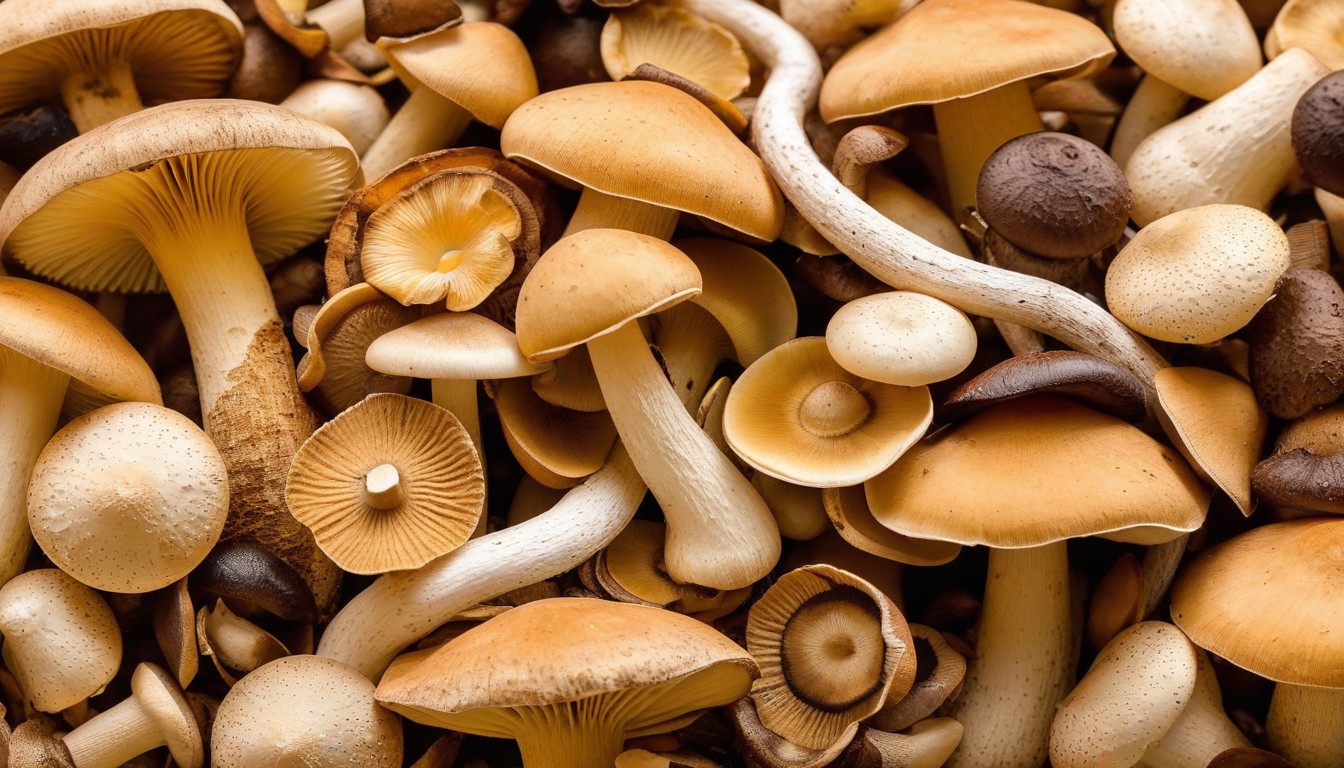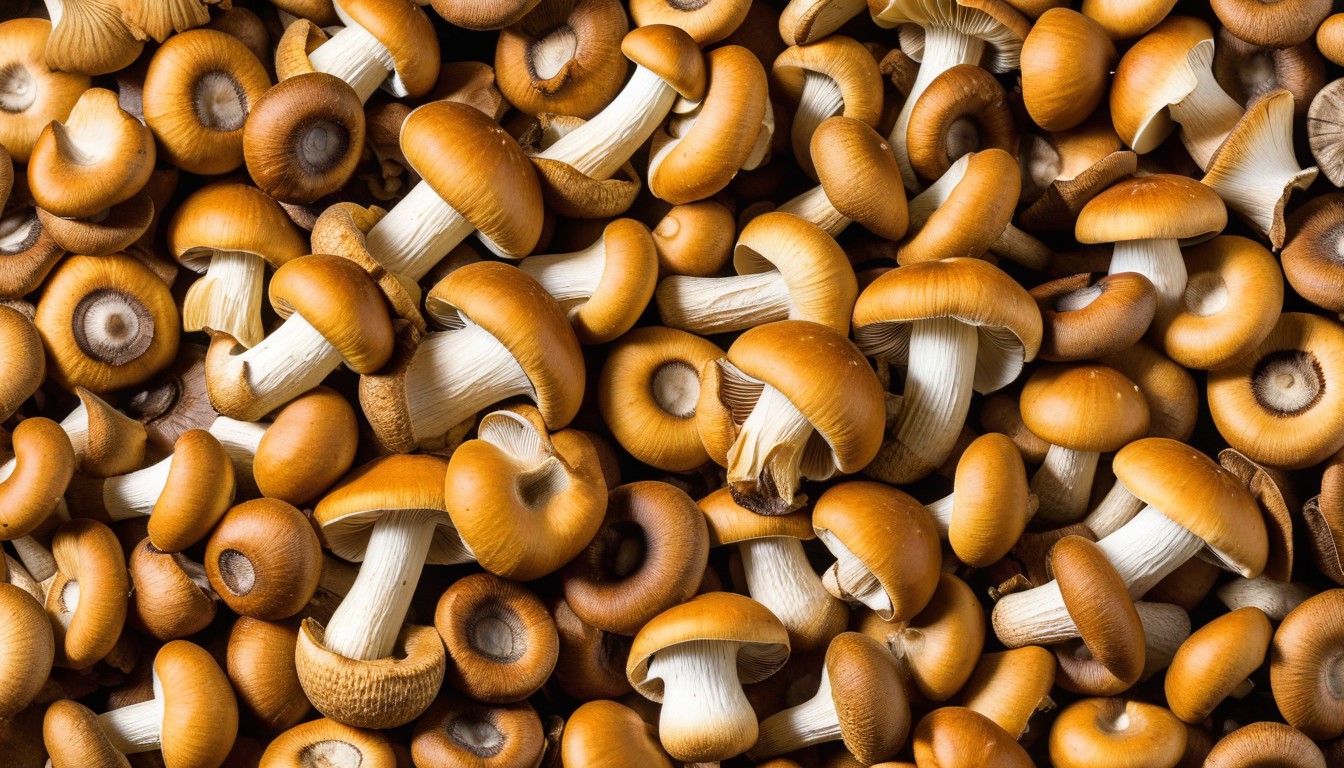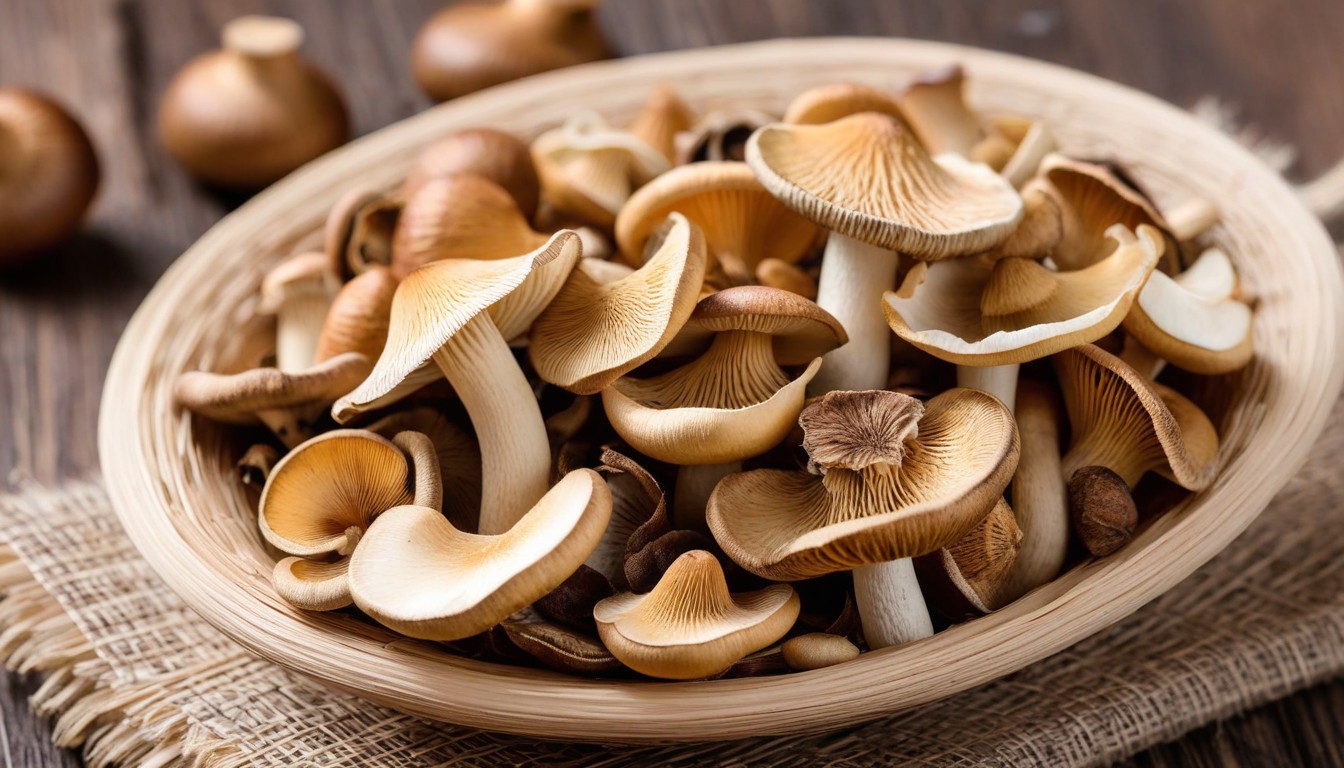Are you a fan of dried mushrooms? Do you ever wonder how long they stay good for consumption or how to store them properly? If so, you’ve come to the right place. In this comprehensive guide, we’ll explore everything there is to know about the shelf life of dried mushrooms. From factors influencing their shelf life to methods of proper storage and culinary uses, we’ve got you covered.
Key Takeaways:
- Dried mushrooms can remain good for one year on average – depending on the type of mushroom, storage conditions, and packaging.
- Proper storage in a cool, dry, and dark place in airtight containers or resealable bags can extend the shelf life of dried mushrooms.
- Signs of spoiled mushrooms include discoloration, foul odor, or the presence of mold, and they should be discarded to prevent foodborne illness.
- Rehydrating dried mushrooms before use is essential, and they can be used in a wide range of dishes for added depth and umami flavors.
- Other preservation methods for mushrooms include canning, pickling, and making mushroom powders.
Understanding Dried Mushrooms
Before we dive into the shelf life of dried mushrooms, let’s first understand what they are. Dried mushrooms are dehydrated fungi that has had the moisture removed while retaining their distinct flavors and nutritional value. They are a popular pantry staple due to their versatility in various cuisines and long shelf life.
There are different types of dried mushrooms, including shiitake, portobello, oyster, and more. Each type has its unique flavor profile, texture, and culinary uses. For example, shiitake mushrooms are commonly used in Asian cuisine and have a meaty texture, while porcini mushrooms are popular in Italian dishes and have a nutty and earthy flavor.
|
Type of Mushroom |
Flavor Profile |
Culinary Uses |
|---|---|---|
|
Shiitake |
Meaty |
Stir-fries, soups, stews, and sauces |
|
Porcini |
Nutty and earthy |
Pasta dishes, risottos, and sauces |
|
Oyster |
Mild and slightly sweet |
Stir-fries, soups, and sauces |
As you can see, dried mushrooms offer a range of flavors and can elevate a dish’s taste and aroma. They are also a great alternative to fresh mushrooms, which have a shorter shelf life and can spoil quickly.
Now that we have a basic understanding of dried mushrooms let’s move on to the factors that can influence their shelf life in the next section.
Factors Influencing Shelf Life
Several factors can affect the shelf life of dried mushrooms, making it essential to store them correctly. Here are the main factors that can impact shelf life:
|
Factor |
Description |
|---|---|
|
Quality of the mushrooms |
The quality of the mushrooms at the time they were dried can affect their shelf life. Fresh and high-quality mushrooms will have a longer shelf life than those that were already old or damaged before drying. |
|
Storage conditions |
The storage conditions play a significant role in the shelf life of dried mushrooms. They should be stored in a cool, dark, and dry place to prevent moisture absorption and mold growth. High temperatures, humidity, and exposure to light can shorten their shelf life. |
|
Packaging |
The type of packaging used to store dried mushrooms can also impact their shelf life. Airtight containers or resealable bags can help maintain their flavor and texture by preventing air and moisture from entering. |
By taking these factors into account, you can ensure proper storage of your dried mushrooms and enjoy their full flavor and nutritional benefits for an extended period.
Shelf Life of Dried Mushrooms

On average, dried mushrooms can last for up to one year, but their shelf life may vary based on several factors. The type of mushroom, the storage conditions, and the packaging can all affect how long they remain good for consumption.
Some mushroom varieties, such as shiitake and porcini, have a longer shelf life than others due to their low moisture content. In contrast, more delicate mushrooms like chanterelles have a shorter shelf life and need to be consumed or used quickly.
Storage conditions are crucial for preserving the quality of dried mushrooms. They are best kept in a cool, dry, and dark place, away from any sources of moisture or heat. Airtight containers or resealable bags can help maintain the flavor and texture of dried mushrooms.
It’s crucial to inspect the mushrooms for any signs of spoilage before using them. Even a small amount of mold can cause foodborne illnesses. If the mushrooms look discolored, have a foul odor, or have visible mold growth, it’s best to discard them.
Table: Factors affecting the Shelf Life of Dried Mushrooms
|
Factors |
Impact on shelf life |
|---|---|
|
Type of mushroom |
Affects moisture content, and thus shelf life |
|
Storage conditions |
Can influence moisture and mold growth |
|
Packaging |
Airtight containers or resealable bags can help maintain quality |
Properly stored dried mushrooms can remain safe for consumption beyond their recommended shelf life. Vacuum sealing or freezing dried mushrooms can extend their shelf life up to two years.
By understanding the factors that influence the shelf life of dried mushrooms, you can ensure their quality and safety for use in your favorite dishes.
Storing Dried Mushrooms

Proper storage is crucial for preserving the quality of dried mushrooms. Follow these tips to ensure your dried mushrooms last as long as possible:
|
Storage Method |
Pros |
Cons |
|---|---|---|
|
Airtight Containers |
– Prevents moisture and mold growth – Maintains flavor and texture – Easy to store and access |
– Can take up space – Can be expensive |
|
Resealable Bags |
– Prevents moisture and mold growth – Affordable and easy to find – Space efficient |
– Can tear or puncture easily – Can be hard to access when partially used |
|
Freezing |
– Can extend shelf life for up to two years – Easy to store and access |
– Can affect texture and flavor – Requires space in the freezer |
Regardless of the storage method you choose, keep your dried mushrooms in a cool, dark, and dry place. Avoid storing them in areas with high humidity or temperature fluctuations, like the kitchen or pantry. Make sure to examine the mushrooms before using them to ensure they haven’t spoiled or been infested by pests.
Tip: It’s a good idea to label your storage containers with the date of purchase or expiration to keep track of how long your dried mushrooms have been stored.
Signs of Spoiled Dried Mushrooms
Dried mushrooms are a great addition to many dishes but can pose a risk if they are spoiled. It’s important to be able to recognize the signs of spoiled dried mushrooms to avoid any potential health risks. Here are some common signs to look out for:
“A musty or off-smell”
“Mushrooms with darker spots or discoloration”
“Mold or fungus growth”
If you notice these signs, it’s best to discard the mushrooms immediately. Consuming spoiled dried mushrooms can cause food poisoning and other health problems. Don’t take any chances – when in doubt, throw them out!
Extending the Shelf Life of Dried Mushrooms
Dried mushrooms can be a valuable addition to any pantry, but their shelf life is not indefinite. To ensure that you get the most out of your dried mushrooms, it’s important to take proper care in storing them. Here are some tips for extending their shelf life:
|
Method |
Instructions |
|---|---|
|
Vacuum sealing |
One effective way to extend the shelf life of dried mushrooms is to vacuum seal them. This method removes air from the packaging, minimizing the risk of moisture and mold growth. If you don’t have a vacuum sealer, you can use a resealable plastic bag with the air squeezed out as an alternative. |
|
Freezing |
Another way to prolong the shelf life of dried mushrooms is to freeze them. They can be stored in an airtight container or plastic bag in the freezer for up to two years. When you’re ready to use them, simply thaw and rehydrate the mushrooms before cooking. |
Both vacuum sealing and freezing are effective ways of preserving dried mushrooms and extending their shelf life, but it’s important to remember that these methods don’t guarantee the mushrooms’ quality. Always examine the mushrooms before using them to ensure they haven’t spoiled or become infested with pests.
By taking proper care in storing dried mushrooms and using the techniques outlined above, you can extend their shelf life and enjoy the unique flavors and nutritional benefits they bring to your dishes.
Using Dried Mushrooms Safely

Using dried mushrooms in your cooking is a great way to add flavor and nutrition to your dishes. However, it’s essential to follow proper safety measures to avoid any health risks. Here are some tips to use dried mushrooms safely:
- Rehydrating dried mushrooms: Rehydration is necessary before using dried mushrooms in your recipes. Soak the mushrooms in warm water or broth for about 20-30 minutes until they are tender. Drain the mushrooms and use them as directed in your recipe.
- Proper handling: Rehydrated mushrooms should be handled with care to avoid contamination. Wash your hands thoroughly before and after handling mushrooms. Use clean utensils and chopping boards when working with mushrooms to prevent cross-contamination with other ingredients.
- Thorough cooking: Rehydrated mushrooms should be cooked thoroughly before consumption. This helps eliminate any harmful bacteria that may be present and also enhances their flavor and texture. Cook the mushrooms until they are tender and fully cooked.
Tip: Avoid eating raw dried mushrooms as they can be tough and difficult to digest.
Recipe Idea: Creamy Mushroom Risotto
One delicious way to incorporate dried mushrooms into your cooking is by making a creamy mushroom risotto. Here’s a quick and easy recipe:
|
Ingredients: |
Instructions: |
|---|---|
|
|
This creamy mushroom risotto is the perfect way to enjoy the rich, earthy flavors of dried mushrooms. Serve it as a side dish or a main course for a delicious and comforting meal!
Culinary Uses of Dried Mushrooms
Dried mushrooms are a versatile and flavorful ingredient that can add depth and richness to a variety of dishes. Whether you’re a meat lover, vegetarian, or vegan, there are countless culinary uses for dried mushrooms. Here are some of our favorite ways to use dried mushrooms in the kitchen:
|
Culinary Use |
Description |
|---|---|
|
Soups and Stocks |
Dried mushrooms are a popular addition to soups and stocks, providing a deep umami flavor. Rehydrate the mushrooms in warm liquid before adding them to the pot. |
|
Pasta Sauces |
Add rehydrated mushrooms to tomato or cream-based pasta sauces for added depth and complexity. |
|
Risottos |
Dried mushrooms are a classic ingredient in risotto, providing a rich earthiness to the dish. |
|
Stuffing |
Add chopped rehydrated mushrooms to your favorite stuffing recipe for a tasty twist. |
|
Veggie Burgers |
Mix rehydrated mushrooms into your veggie burger patties for added flavor and texture. |
|
Broths |
Dried mushrooms can be used to make flavorful vegetarian or vegan broths. Add rehydrated mushrooms to water, along with aromatics like onion and garlic, and simmer for a rich and flavorful broth. |
Experiment with different recipes and techniques to find your perfect use for dried mushrooms. As a pantry staple with a long shelf life, they’re a great ingredient to have on hand for all your culinary creations.
Other Mushroom Preservation Methods

While drying is a popular and effective method of preserving mushrooms, it’s not the only one. Here are some other preservation methods to explore:
Canning
Canning is a common method for preserving various foods, including mushrooms. The process involves placing the mushrooms in a jar and sterilizing them at high heat. Canned mushrooms have a longer shelf life than fresh mushrooms but may have slightly altered texture and flavor due to the canning process.
Pickling
Pickling is another preservation method that involves soaking mushrooms in a vinegar solution. The acidic nature of the vinegar helps preserve the mushrooms, giving them a tangy flavor. Pickled mushrooms are often used as a condiment or added to salads for a burst of acidity.
Mushroom Powder
Making mushroom powder involves dehydrating mushrooms until they are brittle and then grinding them into a fine powder. The mushroom powder can be stored in an airtight container and used as a seasoning or flavor enhancer in a variety of dishes.
Each method of mushroom preservation offers unique flavors and textures, allowing you to enjoy mushrooms year-round. Experiment with different methods and find the ones that work best for you.
Conclusion
Dried mushrooms are a versatile ingredient that can add depth and flavor to various culinary dishes. Understanding their shelf life and proper storage is essential to ensure their quality and safety for consumption. By storing them in cool, dark, and dry conditions, you can extend their shelf life and experiment with different preservation methods like vacuum sealing, freezing, canning, pickling, or creating mushroom powders.
Rehydrating dried mushrooms before use is crucial, and cooking them thoroughly is vital to avoid any health risks. Dried mushrooms are excellent in soups, stews, sauces, risottos, and vegetarian and vegan recipes.
So go ahead, discover their endless possibilities, and enjoy the unique and delectable umami flavor they add to your dishes.
FAQ
How long are dried mushrooms good for?
Dried mushrooms can remain good for consumption for up to one year, provided they are stored properly.
What are dried mushrooms?
Dried mushrooms are dehydrated fungi that have been processed to remove moisture while retaining their flavors and nutritional value.
What factors influence the shelf life of dried mushrooms?
The quality of the mushrooms, storage conditions, and packaging can all affect the shelf life of dried mushrooms.
How should I store dried mushrooms?
Dried mushrooms should be stored in a cool, dark, and dry place in airtight containers or resealable bags.
How can I tell if dried mushrooms have spoiled?
Signs of spoiled dried mushrooms include discoloration, foul odor, or the presence of mold.
Are there any ways to extend the shelf life of dried mushrooms?
Yes, vacuum sealing or freezing dried mushrooms can help extend their shelf life.
How do I safely use dried mushrooms?
Dried mushrooms should be rehydrated by soaking them in warm water or broth before cooking them thoroughly.
What are the culinary uses of dried mushrooms?
Dried mushrooms are commonly used in soups, stews, sauces, risottos, and vegetarian/vegan recipes for their depth and umami flavors.
Are there other methods to preserve mushrooms besides drying?
Yes, alternative preservation methods include canning, pickling, and making mushroom powders.

